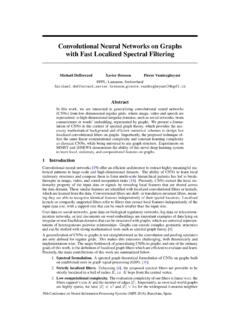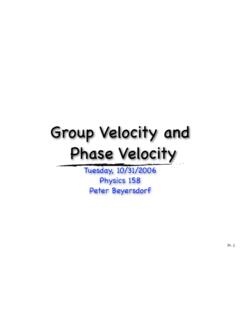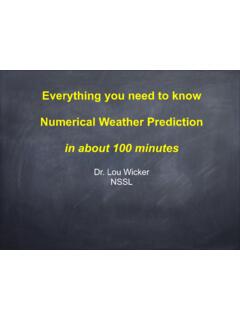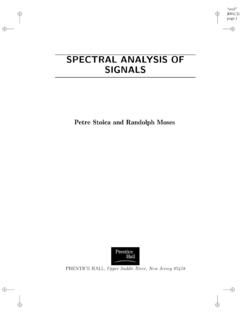Transcription of SUBMITTED TO IEEE TRANSACTIONS ON GEOSCIENCE AND …
1 SUBMITTED TO IEEE TRANSACTIONS ON GEOSCIENCE AND REMOTE SENSING1 BASS Net: Band-Adaptive spectral - spatial FeatureLearning Neural Network for Hyperspectral ImageClassificationAnirban Santara*, Kaustubh Mani*, Pranoot Hatwar, Ankit Singh, Ankur Garg, Kirti Padia and Pabitra MitraAbstract Deep learning based landcover classification algo-rithms have recently been proposed in literature. In hyperspectralimages (HSI) they face the challenges of large dimensionality, spatial variability of spectral signatures and scarcity of labeleddata. In this article we propose an end-to-end deep learningarchitecture that extracts band specific spectral - spatial featuresand performs landcover classification.
2 The architecture has fewerindependent connection weights and thus requires lesser numberof training data. The method is found to outperform the highestreported accuracies on popular hyperspectral image data Terms Convolutional Neural Network (CNN), deeplearning, feature extraction, hyperspectral imagery, landcoverclassification, pattern classificationI. INTRODUCTIONH yperspectral imaging [1], [2] collects rich spectralinformation from a large number of densely-spaced contiguousfrequency bands. It produces three dimensional(x,y, )datavolumes, wherex,yrepresent spatial dimensions and represents spectral image classification [3] is the task of as-signing a class label to every pixel.
3 This paper studies land-cover classification in hyperspectral images where the taskis to predict the type of land-cover present in the locationof each pixel. There are several challenges associated withhyperspectral data the most critical of which are as follows[4].1) Curse of dimensionality resulting from large number ofspectral ) Scarcity of labelled training ) Large spatial variability of spectral approaches have been followed in literature for HSIclassification. The simplest of them are based onk-nearestneighbors (k-NN).
4 In these methods, given a test sample,* Denotes equal Santara and P. Mitra are with the Department of Computer Science andEngineering, Indian Institute of Technology, Kharagpur, WB, 721302 India(e-mail: Hatwar and A. Singh are with the Department of Electrical Engineer-ing, Indian Institute of Technology, Kharagpur, WB, 721302 India Mani is with the Department of Geology and Geophysics, IndianInstitute of Technology, Kharagpur, WB, 721302 India (e-mail: Garg and K. Padia are with Space Applications Centre, IndianSpace Research Organization (ISRO) Ahmedabad, GJ, 380015 India distance in the input space or a transformed spaceis used to find theknearest training examples and a class isassigned on the basis of them.))
5 In [5] and [6] some modifiedversions of thek-NN algorithm have been proposed for HSIclassification. Support Vector Machine (SVM) classifier is amaximum margin linear classifier [7]. Melghani et al. [8]introduced SVM Classifier for HSI classification. SVM basedmethods, in general, follow a two step ) Dimensionality reduction in order to address the prob-lems of high spectral dimensionality and scarcity of la-beled training examples. Some of the methods followedfor dimensionality reduction are subspace projection [9],random feature selection [10] and Kernel Local FisherDiscriminant Analysis [11].
6 2) Classification in the reduced dimensional space usingSVM [8], [9], [12].Li et al. [12] propose local Fisher s Discriminant Analysisfor dimensionality reduction and Gaussian Mixture Model(GMM) for classification. Mianji et al. [13] propose GaussianNon-linear Discriminant Analysis for dimensionality reductionand Relevance Vector Machine for classification. Samat etal. [14] introduced Extreme Learning Machine (ELM) forHSI classification. ELM [15] is a two layer artificial neuralnetwork in which the input to hidden weights are randomlychosen and the hidden to output weights are learned byminimizing a least squares objective function.
7 In [6] LBPis used to extract texture based local descriptors which arecombined with global descriptors like Gabor and spectralfeatures and fed into an ELM for classification. Lu et al.[16] proposed a set-to-set distance based method for deep neural networks [17], [18] have been em-ployed for landcover classification in HSI. Deep learningmethods for HSI classification [19] focus on spectral -spatialcontext modeling in order to address the problem of spatialvariability of spectral signatures. They fall into two broadcategories.
8 The first category [20] [24] follows a ) Dimensionality reduction and spectral - spatial featurelearning using Autoencoder. Autoencoder [25] is anartificial neural network architecture that learns to re-construct the input vector at the output with minimumdistortion after passing through a bottleneck. The vectorof activations in the bottleneck is a reduced [ ] 2 Dec 2016 SUBMITTED TO IEEE TRANSACTIONS ON GEOSCIENCE AND REMOTE SENSING2representation of the input vector that often encodesuseful semantic ) Classification using multi-class logistic second category of methods use Convolutional NeuralNetworks (CNN) [18], [26] for feature learning andclassification in an end-to-end fashion.
9 CNN uses extensiveparameter-sharing to tackle the curse of dimensionality. Hu etal. [27] introduced CNN for HSI classification. The proposedarchitecture is designed to learn abstract spectral signatures ina hierarchical fashion but does not take into account spatialcontext. In [28] compressed spectral features from a localdiscriminant embedding method are concatenated with spatialfeatures from a CNN and fed into a multi-class et al. [29] and Chen et al. [30] propose end-to-endCNN architectures for spectral - spatial feature learning andclassification.
10 In [31] the idea of classifying pixel-pair featuresusing CNN is introduced to compensate for data a voting strategy is proposed for test time to providerobustness in heterogeneous this paper we present a deep neural network architecturethat learns band-specific spectral - spatial features and givesstate-of-the-art performance without any kind of data-setaugmentation or input pre-processing. The architectureconsists of three cascaded blocks. Block 1 takes ap p Ncinput volume (Nc=number of spectral channels) andperforms a preliminary feature transformation on the spectralaxis.
![arXiv:0706.3639v1 [cs.AI] 25 Jun 2007](/cache/preview/4/1/3/9/3/1/4/b/thumb-4139314b93ef86b7b4c2d05ebcc88e46.jpg)

![arXiv:1301.3781v3 [cs.CL] 7 Sep 2013](/cache/preview/4/d/5/0/4/3/4/0/thumb-4d504340120163c0bdf3f4678d8d217f.jpg)
![@google.com arXiv:1609.03499v2 [cs.SD] 19 Sep 2016](/cache/preview/c/3/4/9/4/6/9/b/thumb-c349469b499107d21e221f2ac908f8b2.jpg)







![arXiv:1801.07455v2 [cs.CV] 25 Jan 2018](/cache/preview/c/1/f/1/b/a/a/5/thumb-c1f1baa5f6e090b207f4f18380d23ecd.jpg)





